As an Amazon Associate, I earn from qualifying purchases with no additional costs for you.
Many wine collectors, enthusiasts, and sommeliers will dream of owning their wine cellar with their favorite vintages from robust wine regions. But there are crucial components that are required for a wine cellar to function efficiently so it will keep your most valued wine at its finest.
What makes a good wine cellar? To create an excellent wine cellar, you will first need to decide the types of wine and how much you are looking to store. Creating a cellar that is specific to your collection will help in your planning. Here are the top items that make for a good wine cellar:
- Appropriate Room Size
- Proper Temperatures, Humidity, and Insulation
- Finding the Best Type and Style of Racks
- Designing the Cellar to Match the Collection
Wine cellars depend on strategic planning. That panning includes sticking to the guidelines regarding how to store different types of wine. Even though the technical concerns are important, the wine cellar can still be a creative outlet. Feel free to design and decorate it in ways that will do justice to the collection.
If you are curious about what the average cost is for a wine cellar installation and build, check out this detailed and comprehensive article where I provide real-life examples. For a complete list of the best wood and materials needed for a good wine cellar, check out this article.
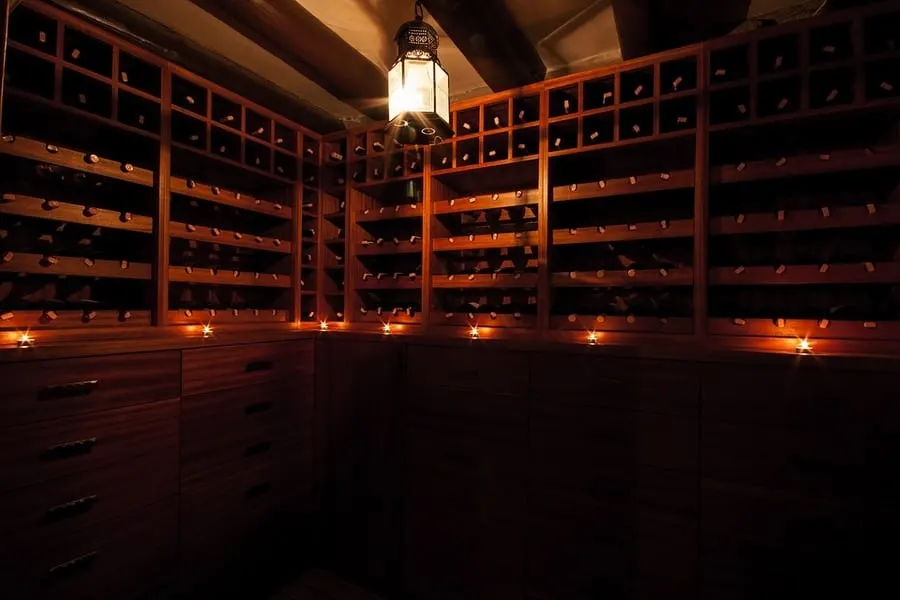
TIP: If you want to check out the best refrigerator for wine storage, I recommend trying out the Avation (18 bottles) compressor refrigerator with Wi-fi smart app control cooling system. You can find this refrigerator by clicking here (Amazon link).
How Big Should a Wine Cellar Be?
The size of the ideal wine cellar will be dependent on the size of the collection. It will also depend on the type of design and racks you decide to use.
For a basic reference point, you can easily fit around 500 bottles of wine in a 25-square-foot room. This would consist of racks lining each wall.
As you scale and grow a collection, the size of the room can become tricky. Therefore, you always want to plan for the future. Anyone building a wine cellar should be thinking at least 10 to 20 years ahead, so they can account for the new wines and collections they will adopt for the cellar.
A few things to keep in mind when considering the ideal size of your wine cellar:
- How big your current collection is
- What your goals are for the next 10 to 20 years for acquiring new wines
- Cooling and insulation costs
- How many of these wines you will be holding versus using, selling, or giving away
Let’s say you currently have 100 bottles in your collection, but you have some pretty big plans for the next decade or so and would like to expand that collection. Here are a few quick steps to calculating size:
- Map out the number of bottles you’d like to buy every year. It becomes much easier if you plan it every month and go from there. Do you have goals for how many bottles you’d like to acquire each month? For this example, we’ll say you want to buy another 75 bottles per year.
- Think about how long bottles are going to stay in your cellar. If you are looking to age your wine and have it remain untouched for more extended periods, go ahead and plan for that. A reliable general plan would be to estimate you will have bottles for 10 years.
- Multiply those two numbers and add the number of bottles you currently own. For this example, you would purchase 750 bottles over the next 10 years. Don’t forget that you also need to accommodate the 100 bottles you already have.
So, for this example, you will want to plan your cellar to accommodate at least 850 bottles.
TIP: Should you always store wine in glass bottles or plastic? Read this article to find out. To find out how long organic wine lasts, check out this guide.
It’s always smart to plan for more space, though. So, once you do some of your calculations to get an estimate of the size room you will want, go ahead and tack on another 10-20%. A little extra cushion now will be well worth the cost. Rebuilding or expanding later will be more expensive.
Going 10-20% over is a good idea, but if you go much over that, you should also weigh the costs of maintenance. The larger the room, the more you will have to cool. That costs money. You will have more equipment to maintain. Again—money.
You should also consider that not all wines are meant to be kept for 10, 20, or 30 years. The majority of wines produced are not intended for long-term aging. They are designed to be consumed within the first few years.
So, as you plan the number of wines you would like to store here, it is also wise to do some preliminary research on the types of bottles you will be seeking.
The Use of the Cellar
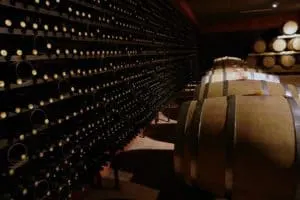
Aside from the logistics, there may be more to consider for the size. What is the cellar being used for? (We know…wine.) But is this meant to be a room that will be shown off to colleagues or friends?
Or will this be exclusively for storage and keeping your collection in top condition? Maybe it is going in the cellar of a restaurant where tours will be offered to patrons.
Consider the space you will need for actual storage while also thinking about what else you may need space for. That can also apply to someone building a wine cellar for a smaller niche collection.
Many times, these wines will be fewer and far between to come by. But you may hit the jackpot one month and purchase a large set.
Planning for slightly more than your goals will always help in the long run. The ideal size for a wine cellar will come down to all those factors and will be specific to your collection, your tastes, and your needs.
Having the Best Storage Conditions
The key to having an excellent home for your wine collection comes down to knowing the proper storage techniques and conditions. After all, these are rooms solely designed for not only the safekeeping of wine but to give it a place to flourish.
Temperature
According to a research project completed by food scientist, Fulvio Mattivi, of the Fondazione Edmund Mach institute in San Michele all’ Adige, Italy, the very smallest of temperatures can affect the overall quality of the wine.
“We discovered that a relatively small difference in the temperature speeds up to several chemical reactions associated with wine aging and even promotes new reactions that are not observed at lower temperatures. After six months under domestic conditions, the wine in the bottle was approximately as old as a bottle from the same producer and lot stored for two years under cellar conditions. The house-stored wine was aging approximately four times faster.” – Fulvio Mattivi
When you see minor spikes or drops in the temperature, you may not think much of it. But as Mattivi points out, even the smallest changes can result in poor longevity for your wine.
Keep it cool, but not too cool. The ideal temperature for your wine cellar is around 55 degrees Fahrenheit.
What Happens If it Gets Too Hot?
When it comes to wine, you should always consider heat to be enemy number one. Anything above 70 degrees will result in wine aging much faster than it should. The heat speeds up the aging process quickly. This is why frequent monitoring and tracking of temperatures is so essential.
It’s every wine enthusiast’s nightmare to uncork a bottle of 20-year-old Bordeaux to realize it has gone bad. Wine going bad can be for many reasons, but heat is a real killer.
If the temperature continues to climb past 70 degrees, it can “cook” the wine. This means it has a stewed, dull flavor that was caused by heat. Scientific studies performed by Pérez-Coello & colleagues (2003) and by Scrimgeour & colleagues( 2015) confirm that storing wine in warmer temperatures can negatively impact wine.
Pro Tip: For bottles that you are only aging for a couple of years, small changes in heat won’t be as detrimental. But if you have a cellar filled with vintages from decades ago, then the temperature should be monitored extremely carefully to ensure it stays in the 45 – 65 range. But ideally, keeping it in a 5-degree range is ideal.
TIP: If you want to learn about how heat affects Champagne, for example, check out this eye-opening article. You may also want to know if wine can be effectively stored at room temperature. Read here to find out.
What Happens If It Gets Too Cold?
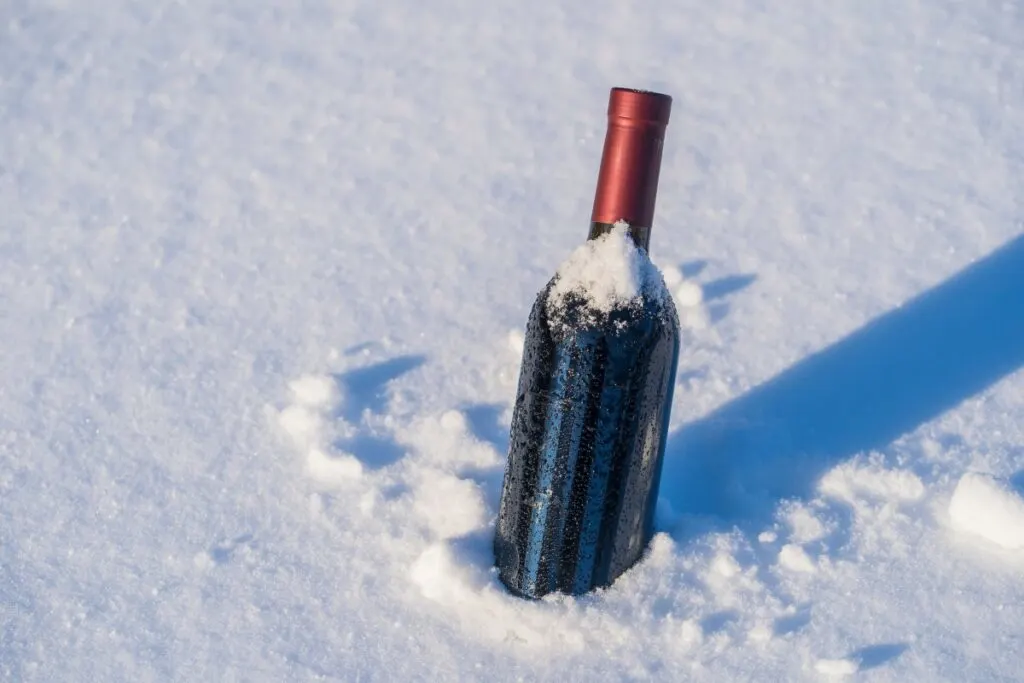
If heat is enemy number one, cold is enemy number two. Many people will opt to keep whites or lighter reds in their refrigerator for a while, thinking they just need to keep it away from heat for storage.
While it is true that heat is truly the number one killer of fine wine, keeping it in a fridge and letting it get too cold can be equally as devastating to a nice bottle.
If you store wine in the fridge for a couple of months, that should be fine. But anything longer than that will not be good for the longevity of the wine. The average fridge will drop below 45 degrees, which is the lowest you should be storing your wines.
Aside from the temperature in a fridge, you also must consider the lack of moisture, which can cause corks to dry out. If the cork dries out, it can create gaps and holes that will provide a pathway for air to reach the wine and cause damage.
TIP: To learn at what temperature different types of wine freeze and how to properly thaw frozen wine and make it taste great, check out this article.
Cooling System Options:
To control the room and maintain proper temperatures, you want to consider your cooling system options – through the wall, split cooling systems, and ducted cooling systems.
| Through the Wall | Split Cooling System | Ducted Cooling System |
| Cost-effective units that require space | Condensing unit stays in a remote location | The entire unit is remote and cool air is ducted into the cellar |
| Easy to install | Evaporator coils and fan stay in the cellar | Can be serviced by most HVAC professionals |
| Fully charged upon delivery and ready to use | The majority of the noise comes from the unit outside the cellar | Maximizes space, with no part of the unit being inside the cellar |
| Downside: They take up space in the cellar and can be a noisier option | Downside: Requires professional installation | Downside: Vents must be designed into the building structure. Otherwise, a retrofitting will be expensive |
| Cost: $1000 – $3500 | Cost: $5000 and up | Cost: $3000 – $6000 |
TIP: Most wines go bad once you pop the cork within a day or so. But a Coravin Wine Preservation system (available for a great price on Amazon) can extend the life of your opened wine for weeks or even months. It is awesome. You should check it out to see if it fits your lifestyle.
Humidity
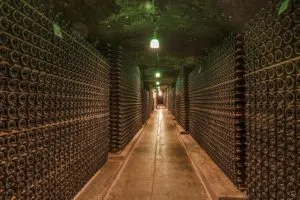
Speaking of moisture, the humidity levels are another critical component of having an efficient wine cellar. You want the relative humidity levels to be lower, around 50-70%. Just like with temperature, balance is vital.
If the humidity gets above 70% – it will likely cause mold around the cellar and the bottles, along with degradation of the labels and glue on the bottles
If the humidity drops below 50% – the corks may become dried out quicker, causing airflow to be allowed to reach the wine, which causes aging at a rapid pace and can cause the wine to go bad quite quickly.
A great way to sort your humidity issues for your cellar will be to integrate a humidifier into your cooling unit. This will allow the humidity to be controlled while you are also managing the temperature. It is recommended you use a mounted humidifier that integrates with the cooling system, requiring no additional power source.
An integrated system will push the humidity levels directly into the airstream with humidity control up to around 60%.
You can also opt for a stand-alone unit to control the humidity that will be mounted separately from your other cooling units. If you want to learn the 8 proven effective steps for great long-term wine storage, check out this article I wrote last week. You may also be interested in the Dos & Don’ts of Wine Storage.
TIP: Check out this simple and cheap hygrometer (Amazon link) for measuring humidity levels in the cellar.
Insulation
The insulation of the cellar will be the piece that ties it all together and helps you maintain those specific temperatures and humidity levels. You will need to create an insulated space that will create a moisture barrier and assist in your efforts to control the environment.
According to Cellar Pro, you should stick with a minimum R12 and R19. This is a measure of thermal resistance. The higher the number, the harder it works to prevent heat conduction.
If the cellar has an exterior wall, you may even need to go as high as R30 for that wall. A vapor or moisture barrier is equally as important as proper insulation.
That barrier should be installed on the outside of the cellar insulation. It needs to be on the warmer side of the insulation to prevent condensation from forming. If that condensation reaches the insulation, it can cause mold and further damage.
Lastly, you will want an airtight seal on the door(s) to access your cellar. There should be no airflow through that door since there is no control over the elements on the other side.
Your cooling unit should ideally be installed on an exterior wall if you have one. This will control the ventilation and the air coming and going.
So, there should be no airflow through the door itself. You can easily accomplish this with weather-stripping or using a door-sweep, which will create a seal around the door to stop that airflow.
Additional Storage Tips
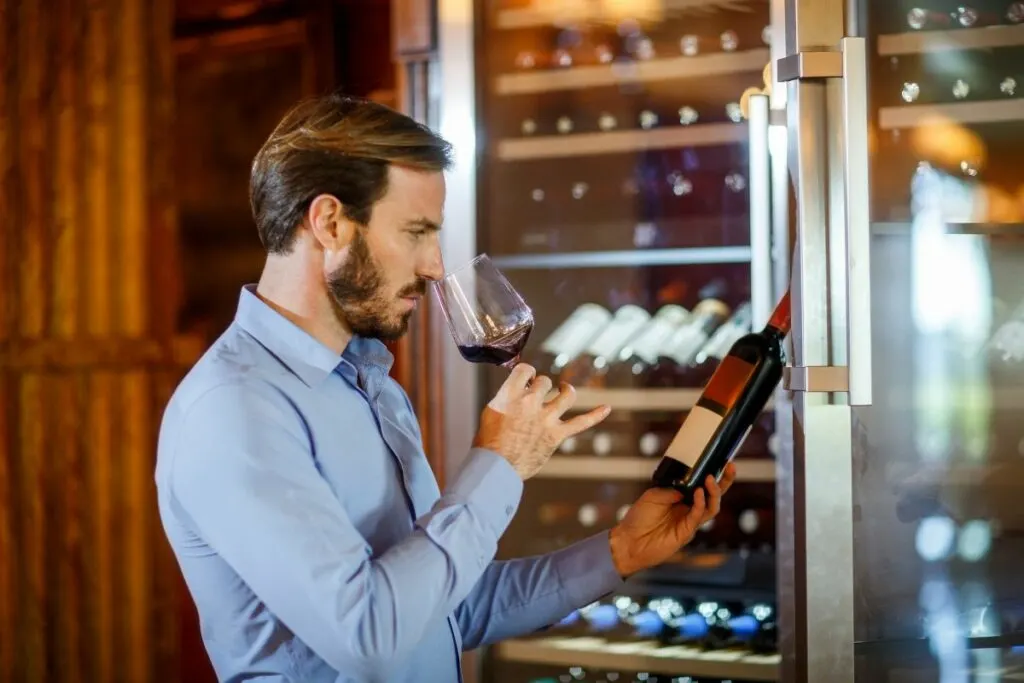
- Keep it Dark: Not only are wines stored in cellars because they stay naturally cooler, but they stay naturally dark. Light, but specifically sunlight, will damage wine that you want to store long-term. Think about the bottles themselves. They are colored for a reason – to block out light the same way sunglasses do for our eyes. UV rays can prematurely age wine and cause degrading.
The light from standard bulbs in your home typically won’t be strong enough to cause much harm, but overtime for the wines you maturely age, they can cause fading on the labels. Stick with incandescent bulbs over fluorescent, since fluorescent light emits tiny amounts of ultraviolet light.
- Keep the Wines Still: This seems like a silly one since your wines will be sitting in a cellar. But for older vintages, especially, the movement to the wine can alter the taste and elements of the wine. This is something to consider in your planning for the cellar. Keep the older vintages together in a corner where stability is best.
If this is a cellar that people will be visiting from time to time, whether it is friends and family or clients on a tour – you want these to remain untouched.
While minor shaking or movement won’t ruin the wine, constant or major movement can affect the flavor and quality of the wine.
Old wine is fragile wine, so slight shakes or sudden movements can result in the separation of flavors and disturb the sentiment. When you have older vintages that you need to move, or you are ready to drink, be sure to handle them gingerly.
“Age is just a number. It’s irrelevant unless, of course, you happen to be a bottle of wine.” ― Joan Collins
- Side Storage: Storing bottles horizontally, on their sides, is the standard for wine storage. This is mainly so that wine is pressed against the inside of the cork. If the cork dries out, it will allow air to enter the bottle.
It is also a space-saver. When you store them on their sides, you can store many more bottles than if you had them standing upright.
But if for some reason, you would like some bottles to stand upright – maybe aesthetically, it looks better, or you want to feature a few bottles for people to see – it is okay for a couple of scenarios.
- Screwcaps, glass, or plastic corks because you no longer must worry about the cork drying out
- Short to mid-term storage. If you plan to drink these bottles soon, it won’t cause an issue to have them standing upright.
TIP: Speaking of the whole horizontal vs. vertical wine bottle debate, check out this article which tackles it from every angle.
Recommendation box: Everything you need to enjoy your wine as much as possible. All recommended products are personally tested and regularly used by experts from this website (Amazon links):
> Ivation Wine Cooler – Energy-efficient wine cooler for 18 bottles with Wi-fi smart app control cooling system.
> Wine Rack – Beautiful, elegant wood rack for up to 7 bottles and the choice of vertical or horizontal storage.
> Durand Wine Opener – Classic vintage wine opener (we like all these classic staff).
> YouYah Iceberg Wine Decanter – The most beautiful and handy wine decanter we personally use.
> Bormioli Rocco Wine Glasses – A set of eight elegant and traditional wine glasses made in Italy.
> Vintorio Wine Aerator – Simple but really useful wine aerator for a reasonable price.
> The Original Vacu Vin Wine Saver – The best wine saver on the market in a package with two vacuum stoppers and two wine servers.
And if you want to become a true connoisseur of wine, we recommend reading the book Wine Folly: The Essential Guide to Wine (Amazon link), where you will find all the information you need about winemaking, wine varieties, flavors, and much more.
What are the Best Wine Racks?
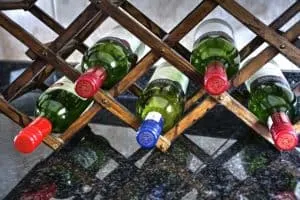
There are plenty of different styles and types of racks to choose from, so having a clear picture of the aesthetic, number of bottles, and capabilities of your room will be essential to your plans.
Some of the most popular types of racks are:
- Bins or Cubes
- Scalloped
- Tabletop
- Stackable
- Lattice Cube
TIP: Having quality storage racks for your wine is not only practical but can also serve as a nice design accessory for your home. We loved these (Amazon links):
- Ferfil Wine Rack (10 Bottles): Concertina/scissor fold wooden wine rack made of solid, eco-friendly wood.
- Gusto Nostro Wood Wine Rack: Beautiful, elegant design, the possibility of storing up to 7 bottles, and the choice of vertical or horizontal storage.
As mentioned earlier, you will want the majority of your racks to allow for horizontal storage to save space and keep the corks moist. The best wine cellars have racks that accomplish a variety of tasks.
- Proper storage for the condition of the wine
- Space efficient
- Fits the aesthetic of the collection and room
- Sturdiness to prevent shaking or vibrations
Having a mix of different types of racks will allow you to maximize your space but also design it to your needs and preferences.
Lining the walls with racks will always be a space saver, but it is nice to have room for a few tabletops throughout the cellar if you like to do quick tastings down there as well.
The wood used should be based on the humidity standards for a cellar. The best type of wood for the racks is Redwood. It is the most popular choice because it is resistant to mold.
Other species of wood that are popular for the same reason are black walnut and mahogany. Pine is used from time to time as a less expensive model, but it doesn’t allow for the same resistance to mold and moisture-related damage.
For stability reasons, having built-in racks is the best way to go. It will help limit those vibrations or shaking and, of course, help reduce the chance of anything tipping over. This is something each owner of a wine cellar must consider individually, though.
If this collection is somewhere that you will be keeping it for the next few decades, then built-in is the way to go. But if your future there is uncertain, or you might want to move things around, then stick to less permanent options.
The built-in option will cost more but provides a beautiful and classic look while keeping everything secure. It will also bring you a return on the investment if it is a home cellar that you sell someday. The value of that cellar will increase immediately with beautiful built-ins.
Finding the Best Design for the Wine Cellar
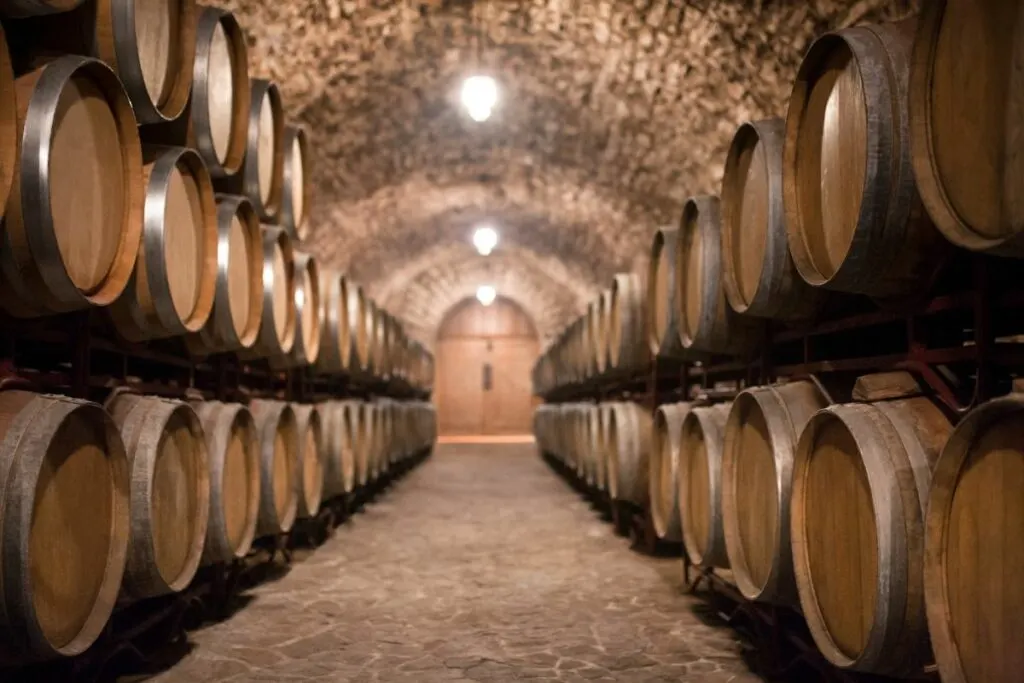
Once you know your distinguished collection is well taken care of and functioning efficiently, you have the fun of decorating and making it unique to you and your collection.
The best wine cellars know how to design an aesthetic that also serves a purpose. They find a way to be as functional as they are visually engaging.
A popular option for many cellars is keeping bare soil flooring. If you are lucky enough to have a space that is soil, it will provide the best flooring for the environment.
This will help in your battle to maintain proper humidity by adding it into the air naturally. From there, you can rely on your humidifier to do the rest of the work and monitor the percentages.
The bare soil also adds a different vibe and style to the cellar that brings an antique or rustic style. If you don’t have bare ground, concrete will still do just fine.
You just don’t want to have any carpeting in there, unless it is designed specifically for outdoor use so that you won’t have mold build-up.
The issue with carpets in this environment will always be mold. If you decide you’d like a throw rug here or there for the look of the cellar, just be sure it is a thinner rug that will not take in a lot of moisture. Beware that you may still need to replace these from time to time due to mold.
Understanding the Collection and Your Needs
Every wine cellar is going to be unique to the collection it is storing. The specificity of the cellar is going to be the key. Wine cellars have become not only a place to store wine in ideal conditions properly but also a way to showcase the wine.
It can be as simple as a room that has wine racks lining the walls, or a custom-designed room that matches the aesthetic of the collection, the bar, or the home that it is for. Both can be equally beautiful and purposeful.
TIP: Wine racks should always lean forward, Find out why here. Are wine refrigerators only for white wine? This article explains.
Some of the most exquisite cellars are designed around the collection itself. Do you have a robust selection of Italian reds? Or maybe you specialize in whites from France. If you have a consistent theme in your collection, it can be beneficial to design the cellar around that idea.
This makes for a fun experience for the owner, but also a truly engaging experience for everyone who has the pleasure of looking through the cellar. This can be equally true for themes outside of the wine itself.
TIP: A suitable wine glass is the basis for enjoying well-being while drinking your favorite wine variety. Here are our favorite ones (Amazon link):
- Bormioli Rocco Crystal Wine Glasses: A set of eight elegant and traditional wine glasses made in Italy for a reasonable price.
- Riedel VINUM Wine Glasses: Luxury set of two wine glasses suitable for any occasion. We just love them!
- Schott Zwiesel Tritan Crystal Glasses: If you like unusual alternatives, a set of six stemless glasses made of crystal glass.
The Elements of a Great Wine Cellar
When you can combine proper storage techniques and an eye for a killer aesthetic, you will end up with the best wine cellar. The most critical elements will always be the conditions inside the cellar and how you monitor, track, and cater to your wines.
These cellars will match your impeccable taste in wine with the conditions they deserve. A wine cellar is a great option if you have space and money to spend. If you are more limited on resources, a wine refrigerator is a great option. Check out this article I wrote on whether wine cooler refrigerators are needed for good wine storage.
TIP: Check out this page for a complete list of wine products and accessories I love. You’ll find my recommendations for wine refrigerators, decanters, and aerators and the best place to buy wine online. Click here to see the complete listing.
Scientific Literature Referenced:
Pérez-Coello, M., González-Viñas, M., Garcı́a-Romero, E., Dı́az-Maroto, M., & Cabezudo, M. (2003). Influence of storage temperature on the volatile compounds of young white wines. Food Control, 14(5), 301-306. doi:10.1016/s0956-7135(02)00094-4 (via: ScienceDirect)
Scrimgeour, N., Nordestgaard, S., Lloyd, N., & Wilkes, E. (2015). Exploring the effect of elevated storage temperature on wine composition. Australian Journal of Grape and Wine Research, 21, 713-722. DOI:10.1111/ajgw.12196 (via Wiley)
